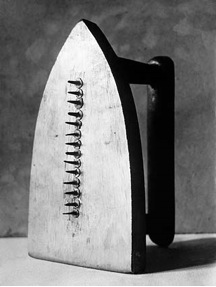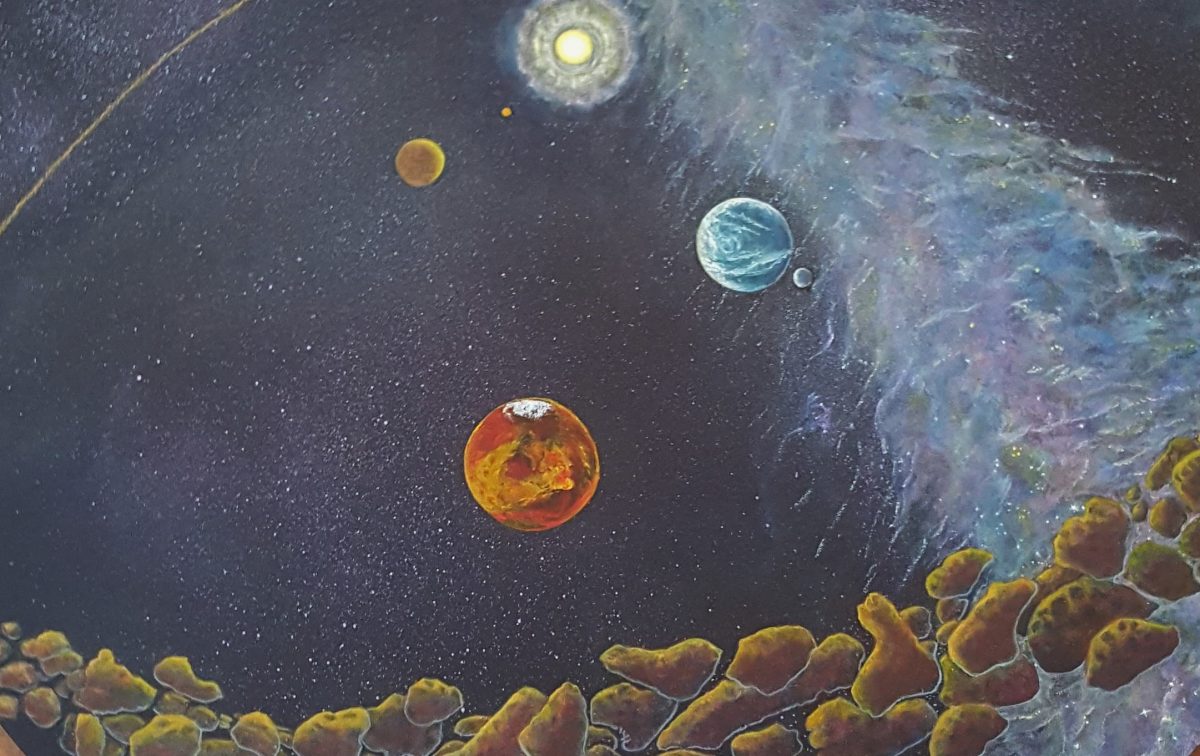Q. 1: By contrasting the works of two different artists note how Abstraction in painting before WW2 followed different directions.
Abstraction in painting was divided into two areas – Formal or Pure Abstraction. The Formal side, following through the Cubism of Picasso and Braque, culminated in De Stijl (The Style) of Piet Mondrian, and the Suprematism of Malevich.

Samovar 1913 MoMA – Malevich
Through a series of tree paintings Mondrian developed his Formal approach – based on the use of cubist planes of colour, and compressed space – until he’d reduced the elements to the use of primary colours, plus black and white, simple geometric shapes, and the intersections of line, for example his COMPOSITION WITH RED, YELLOW AND BLUE painted in 1930. He wanted to create a universal artform that was devoid of subject matter, and emotions, and could be appreciated and understood by persons all over the world. He created harmony, order and balance by the manipulation of the elements of art.
Tree Series – Mondrian
Wassily Kandinsky, on the Pure Abstraction side, formed Der Blau Reiter (The Blue Rider) group of artists who believed in non-figurative but expressive works. He linked colour to music, and talked about a ‘choir of colour’ when he painted his BLUE MOUNTAIN, which, though still containing some imagery, was predominantly painted for its colours and their psychological affects on the viewer. He became more interested in the use of abstract organic shapes in his later works, and worked in series which each work evolving from the previous one, for example his BLACK ARCH series. He used colour and line strongly, boldly; and he wrote a manifesto on his theories of colour. His group believed in working from within, creating art based on the metaphysical plane and not related to life or nature.


Blue Mountain & Black Arch Series – Kandinsky
. . .
Q. 2: By referring to three different works of art, relate how 20th Century sculpture breaks with tradition.
In the 20th Century, sculptors were freed from the restrictions that their materials set them, as new materials became available – plastic, perspex, sheet metal, wire, glass, and also existing items such as the bicycle seat and handle bars Pablo Picasso used to construct his assemblage called BULL’S HEAD, and although it was tongue-in-cheek as a Dada work, Duchamp’s BICYCLE WHEEL constructed from an existing bicycle wheel and stool. Sculptors were free to construct their sculptures.
Bicycle Wheel & Bull’s Head – Duchamp
Henry Moore, with his use of voids, introduced the use of actual space into his sculptures – the sculpture’s mass became the contours of the void within, and also the void allowed the sculpture to interact with the landscape beyond it. RECUMBENT FIGURE shows how Henry Moore used the void to show the weight and mass of the figure, and as an integral part of the work.


Recumbent Figure Series – Moore
Constantin Brancusi abstracted his subjects ruthlessly until only the essence of the subject remained, examples being THE FISH, SLEEPING MUSE, and THE KISS, the latter two of which he made several sculptures. He discarded all unnecessary details – in THE FISH he wanted to show the slippery movement of the fish, so placed it on a motorised pedestal . The use of actual movement was another addition to the modern sculpture , creating unlimited scope through electrification and lighting.


The Fish & The Kiss – Brancusi
. . .
Q. 3: Between the Wars artists reacted against traditional values and logic in society.
Discuss this attitude as seen in two art movements, referencing two artists and at least three works of art
After WW1 a group of artists led by Marcel Duchamp formed a movement called Dada – a silly name chosen for a movement that aimed to show the silliness in society at the time. They wanted to reintroduce the use of imagination, intuition, and free expression by the artist into art – they felt that the formal nature of art at that time was too far removed from reality. They wanted to show that art could be fun, and to give the artist control over art rather than the gallery owners and academics.
Dada took two forms; Readymades – like Man Ray’s THE GIFT, which was an iron with nails protruding from its ironing plate, and Duchamp’s BICYCLE WHEEL made from a bike wheel and kitchen stool – and Jests (or corrected readymades) – like Duchamp’s LHOOQ, a print of Mona Lisa with a beard and moustache drawn on it. There were also Chance works – like Hans Arp’s CONFIGURATION where he used string dropped on the floor to give him the initial image.



The Gift – Man Ray; LHOOQ – Duchamp; Configuration – Hans Arp
The Surrealists followed, developing the idea of the imagination, the dream-world, the meta-physical world, being portrayed free from any restrictions of moral, narrative, aesthetic rules. They encouraged automatic drawing, and chance – Jean Miro used bright primary colours and organic shapes in his works, while Giorgio de Chico used a distortion of perspective and areas of space to create an uneasy feeling with his paintings, for example THE MYSTERY AND MELANCHOLY OF A STREET.


Women and Birds at Sunrise – Miro; The Mystery and Melancholy of a Street – de Chico
Salvador Dali, on the other hand, used Realism with startling clarity in his paintings, like THE PERSISTENCE OF MEMORY, but introduced uneerie elements into his paintings – everyday things in juxtaposition that didn’t belong together – like melting clocks to evoke the feeling of time melting. The Surrealist artists were now not only free of rules, but of reason as well, working in a new fourth dimension level of reality.

The Persistence of Memory – Dali
. . . . .
I would like to challenge other artists out there to see if they can come up with answers to these 3 questions giving different (and perhaps favourite) examples of Art and Artists.
Either LINK them to this blog, or write them as a comment and add your name to them and I will add them to this blog for others to see.
If you wish to quote from this blog you may do so if you reference the quote to this URL.
© Jud House 29/08/2016
